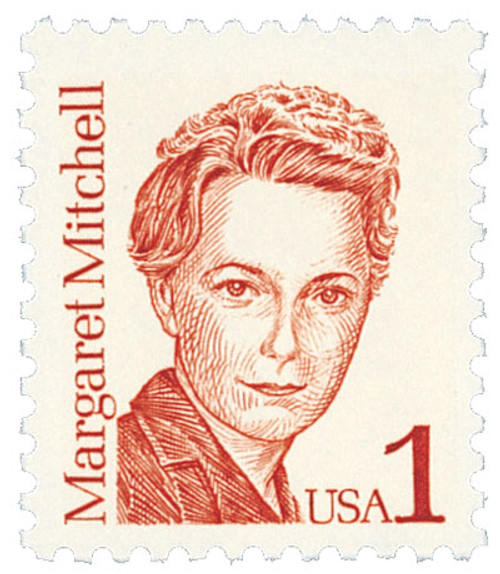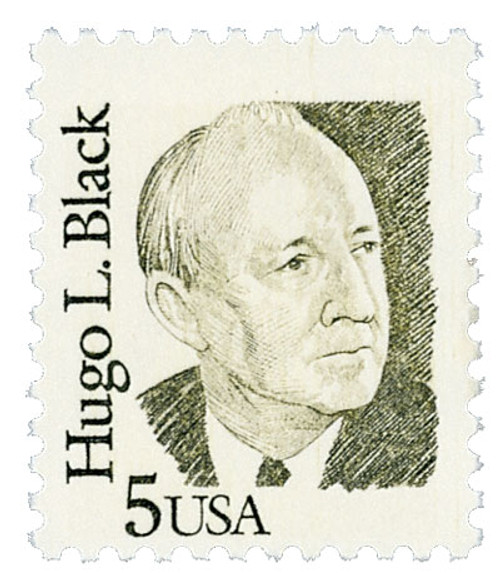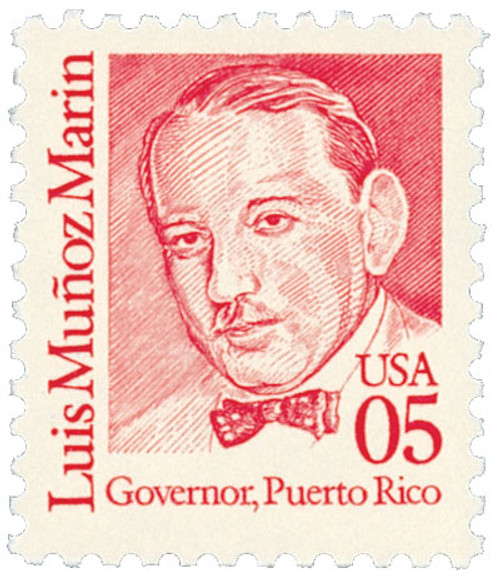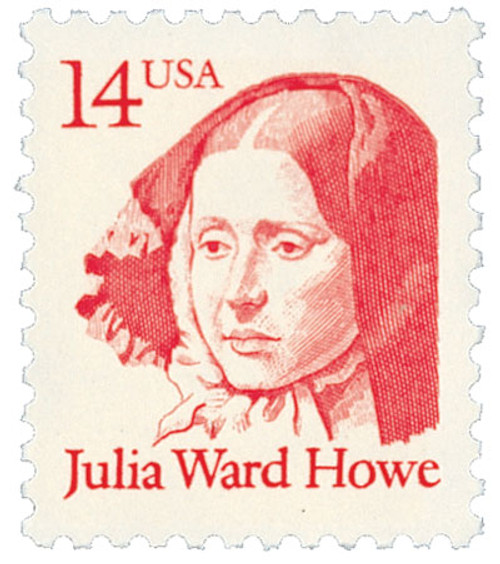
# 2185 PB - 1993 29c Great Americans: Thomas Jefferson
U.S. #2185
1993 29¢ Thomas Jefferson
Great Americans
- Issued on Jefferson’s 250th birthday
- 53rd face-different stamp in Great Americans Series; second in series to feature a president; and the series’ only stamp in 1993
Stamp Category: Definitive
Series: Great Americans
Value: 29¢, first-class rate
First Day of Issue: April 13, 1993
First Day City: Charlottesville, Virginia
Quantity Issued: 500,000,000
Printed by: Stamp Venturers
Printing Method: Engraved
Format: Panes of 100 in sheets of 600
Perforations: 11.3 x 11.2
Color: Indigo
Why the stamp was issued: This stamp replaced the 29¢ Earl Warren issue of 1992.
About the stamp design: The USPS originally planned to feature Jefferson on a stamp promoting World Stamp Expo 2. However, when a new postmaster general stepped in, commitments were reexamined, and the stamp plans were abandoned. The USPS wanted a stamp to honor Jefferson’s 250th birthday, so they reached out to artist Chris Calle, who designed several previous stamps in the series, asking him to provide a quick sketch of Jefferson.
Jefferson had been on many stamps before and the USPS didn’t want this one to resemble any others. So, Calle consulted up to seven different images of Jefferson. The majority of his portrait was based on the 1789 Jean Antoine Houdon bust of Jefferson in the collection of the Museum of Fine Arts, Boston. Because he was an experienced stamp artist they trusted, and time was short, Calle only produced one drawing and the concept-sketch stage was skipped.
First Day City: The First Day ceremony for this stamp was held at Jefferson’s home of Monticello in Charlottesville, Virginia.
About the Great Americans Series: The Great Americans Series was created to replace the Americana Series. The new series would be characterized by a standard definitive size, simple design, and monochromatic colors.
This simple design included a portrait, “USA,” the denomination, the person’s name, and in some cases, their occupation or reason for recognition. The first stamp in the new series was issued on December 27, 1980. It honored Sequoyah and fulfilled the new international postcard rate that would go into effect in January 1981.
The Great Americans Series would honor a wider range of people than the previous Prominent Americans and Liberty Series. While those series mainly honored presidents and politicians, the Great Americans Series featured people from many fields and ethnicities. They were individuals who were leaders in education, the military, literature, the arts, and human and civil rights. Plus, while the previous series only honored a few women, the Great Americans featured 15 women. This was also the first definitive series to honor Native Americans, with five stamps.
The Bureau of Engraving and Printing (BEP) produced most of the stamps, but private firms printed some. Several stamps saw multiple printings. The result was many different varieties, with tagging being the key to understanding them. Though there were also differences in perforations, gum, paper, and ink color.
The final stamp in the series was issued on July 17, 1999, honoring Justin S. Morrill. Spanning 20 years, the Great Americans was the longest-running US definitive series. It was also the largest series of face-different stamps, with a total of 63.
Click here for all the individual stamps and click here for the complete series.
History the stamp represents: Thomas Jefferson was born on April 13, 1743, in Shadwell, Colony of Virginia. Jefferson was the third of ten children in a prosperous family, permitting him to receive private tutoring at the age of five. He was an excellent student and gifted violinist who enjoyed dancing and horseback riding. Jefferson went on to graduate from the College of William & Mary with highest honors and began to study law. Jefferson was admitted to the Virginia bar in 1767.
At the age of 25, Jefferson was elected to Virginia’s House of Burgesses. He emerged as a passionate author who other officials turned to when they needed assistance expressing complex issues. As rebellion swept the New England states, Britain dissolved the House of Burgesses. Its former members, including Jefferson and George Washington, continued to meet secretly to organize a protest against British plans to deport colonists to England for trial.
A convention was called to develop a plan of action for Virginians, and Jefferson was elected to be a delegate. In response, Jefferson wrote A Summary View of the Rights of British America, a powerful presentation of Colonial terms for a settlement with Britain that sparked the independence movement. Jefferson soon became known as one of the most eloquent spokesmen of the patriotic movement.
Jefferson served as a delegate to the Second Continental Congress in 1775. The following year, he was appointed to the Committee of Five, a group given the task of writing the Declaration of Independence. Jefferson was unanimously chosen to draft the document, which was adopted almost exactly as originally written and officially issued on July 4, 1776.
In September of 1776, Jefferson resigned from the Continental Congress and was elected to the new Virginia House of Delegates. He helped reform and update the new democratic state’s laws. Jefferson’s idea of limited restrictions on individual rights, voting rights for small landowners, religious freedom, and separation of church and state were adopted.
As he guided Colonial Virginia through its transition to a democratic state, Jefferson built an estate named Monticello on the property his father had left him. He introduced the first olive trees in North America and experimented with orange trees. Jefferson’s innovations included a swivel chair, a dumbwaiter that transported food from the basement kitchen to the ground-floor dining room by use of a series of pulleys, and a duplicating machine. Following a brief term as governor of Virginia, Jefferson served as U.S. minister to France until the end of the Revolutionary War.
Upon his return to the United States, Jefferson served as the first secretary of state. Appointed by George Washington, Jefferson disagreed sharply with Secretary of the Treasury Alexander Hamilton’s national fiscal policy. The primary debate was over funding the Revolutionary War debt. Hamilton believed the debt should be divided equally among the states. Jefferson, a firm advocate of states’ rights, believed that each state should be responsible for the debt it alone had incurred. Their disagreement led to further divisions in the new government, with Hamilton’s Federalists on one side and Jefferson’s Democratic-Republican Party on the other.
As secretary of state, Jefferson supported France in its war with England. In 1793, he returned to Monticello and began working with James Madison to undermine Hamilton’s influence. Jefferson lost the 1796 presidential election to the Federalist candidate, John Adams. However, he had enough electoral votes to be elected Vice President.
Four years later, the Federalists lost the presidency and control of Congress. Jefferson defeated John Adams and received enough electoral votes to tie with Aaron Burr. The tie for first place in the election was to be resolved by the House of Representatives, which was controlled by the Federalists. After deadlocking in 35 ballots, the House of Representatives chose Jefferson by a margin of ten to four.
Fearful that the U.S. might lose navigational rights along the Mississippi, President Thomas Jefferson sent James Monroe and Robert R. Livingston to Paris to negotiate the purchase of New Orleans and its immediate surrounding area. The U.S. was prepared to pay $10 million for the Louisiana parcel. Jefferson anticipated resistance to his proposal. However, war between France and England seemed inevitable in 1803, and the Louisiana Territory was a distraction for France. To focus his resources on the war, Napoleon Bonaparte offered the entire territory of 530 million acres to the United States for $15 million.
The purchase was the government’s largest financial transaction to date, and it doubled the size of the United States at a cost of less than 3¢ per acre. Control of the Mississippi River and the port of New Orleans provided a convenient method of transportation necessary for the development of the new region. The acquisition also distanced France, a potential enemy, from the young nation.
Jefferson replaced his Vice President Aaron Burr with New York Governor George Clinton and easily won re-election in 1804. Once extremely popular, a series of actions caused public disapproval throughout Jefferson’s second term. Aaron Burr killed Alexander Hamilton in a duel before fleeing west. When Burr was placed on trial for treason, Jefferson’s zealous campaign for the conviction of his former Vice President alienated many observers. At the same time, England and France were at war, and each nation prohibited any other nation from trading with their opponent. Jefferson responded with the Embargo Act, a move that banned trade with the two warring nations. Rather than punish England and France, the Embargo Act severely damaged U.S. commerce and Jefferson’s popularity.
Jefferson returned to his beloved Monticello and resumed his habit of meticulously documenting every facet of Monticello’s daily operations. During the last years of his life, Jefferson renewed his friendship with John Adams. Many of the letters survive today, giving modern historians a glimpse into the thoughts of two of the nation’s most gifted founders. Exactly 50 years after the Declaration of Independence was issued, Jefferson and Adams passed away.
U.S. #2185
1993 29¢ Thomas Jefferson
Great Americans
- Issued on Jefferson’s 250th birthday
- 53rd face-different stamp in Great Americans Series; second in series to feature a president; and the series’ only stamp in 1993
Stamp Category: Definitive
Series: Great Americans
Value: 29¢, first-class rate
First Day of Issue: April 13, 1993
First Day City: Charlottesville, Virginia
Quantity Issued: 500,000,000
Printed by: Stamp Venturers
Printing Method: Engraved
Format: Panes of 100 in sheets of 600
Perforations: 11.3 x 11.2
Color: Indigo
Why the stamp was issued: This stamp replaced the 29¢ Earl Warren issue of 1992.
About the stamp design: The USPS originally planned to feature Jefferson on a stamp promoting World Stamp Expo 2. However, when a new postmaster general stepped in, commitments were reexamined, and the stamp plans were abandoned. The USPS wanted a stamp to honor Jefferson’s 250th birthday, so they reached out to artist Chris Calle, who designed several previous stamps in the series, asking him to provide a quick sketch of Jefferson.
Jefferson had been on many stamps before and the USPS didn’t want this one to resemble any others. So, Calle consulted up to seven different images of Jefferson. The majority of his portrait was based on the 1789 Jean Antoine Houdon bust of Jefferson in the collection of the Museum of Fine Arts, Boston. Because he was an experienced stamp artist they trusted, and time was short, Calle only produced one drawing and the concept-sketch stage was skipped.
First Day City: The First Day ceremony for this stamp was held at Jefferson’s home of Monticello in Charlottesville, Virginia.
About the Great Americans Series: The Great Americans Series was created to replace the Americana Series. The new series would be characterized by a standard definitive size, simple design, and monochromatic colors.
This simple design included a portrait, “USA,” the denomination, the person’s name, and in some cases, their occupation or reason for recognition. The first stamp in the new series was issued on December 27, 1980. It honored Sequoyah and fulfilled the new international postcard rate that would go into effect in January 1981.
The Great Americans Series would honor a wider range of people than the previous Prominent Americans and Liberty Series. While those series mainly honored presidents and politicians, the Great Americans Series featured people from many fields and ethnicities. They were individuals who were leaders in education, the military, literature, the arts, and human and civil rights. Plus, while the previous series only honored a few women, the Great Americans featured 15 women. This was also the first definitive series to honor Native Americans, with five stamps.
The Bureau of Engraving and Printing (BEP) produced most of the stamps, but private firms printed some. Several stamps saw multiple printings. The result was many different varieties, with tagging being the key to understanding them. Though there were also differences in perforations, gum, paper, and ink color.
The final stamp in the series was issued on July 17, 1999, honoring Justin S. Morrill. Spanning 20 years, the Great Americans was the longest-running US definitive series. It was also the largest series of face-different stamps, with a total of 63.
Click here for all the individual stamps and click here for the complete series.
History the stamp represents: Thomas Jefferson was born on April 13, 1743, in Shadwell, Colony of Virginia. Jefferson was the third of ten children in a prosperous family, permitting him to receive private tutoring at the age of five. He was an excellent student and gifted violinist who enjoyed dancing and horseback riding. Jefferson went on to graduate from the College of William & Mary with highest honors and began to study law. Jefferson was admitted to the Virginia bar in 1767.
At the age of 25, Jefferson was elected to Virginia’s House of Burgesses. He emerged as a passionate author who other officials turned to when they needed assistance expressing complex issues. As rebellion swept the New England states, Britain dissolved the House of Burgesses. Its former members, including Jefferson and George Washington, continued to meet secretly to organize a protest against British plans to deport colonists to England for trial.
A convention was called to develop a plan of action for Virginians, and Jefferson was elected to be a delegate. In response, Jefferson wrote A Summary View of the Rights of British America, a powerful presentation of Colonial terms for a settlement with Britain that sparked the independence movement. Jefferson soon became known as one of the most eloquent spokesmen of the patriotic movement.
Jefferson served as a delegate to the Second Continental Congress in 1775. The following year, he was appointed to the Committee of Five, a group given the task of writing the Declaration of Independence. Jefferson was unanimously chosen to draft the document, which was adopted almost exactly as originally written and officially issued on July 4, 1776.
In September of 1776, Jefferson resigned from the Continental Congress and was elected to the new Virginia House of Delegates. He helped reform and update the new democratic state’s laws. Jefferson’s idea of limited restrictions on individual rights, voting rights for small landowners, religious freedom, and separation of church and state were adopted.
As he guided Colonial Virginia through its transition to a democratic state, Jefferson built an estate named Monticello on the property his father had left him. He introduced the first olive trees in North America and experimented with orange trees. Jefferson’s innovations included a swivel chair, a dumbwaiter that transported food from the basement kitchen to the ground-floor dining room by use of a series of pulleys, and a duplicating machine. Following a brief term as governor of Virginia, Jefferson served as U.S. minister to France until the end of the Revolutionary War.
Upon his return to the United States, Jefferson served as the first secretary of state. Appointed by George Washington, Jefferson disagreed sharply with Secretary of the Treasury Alexander Hamilton’s national fiscal policy. The primary debate was over funding the Revolutionary War debt. Hamilton believed the debt should be divided equally among the states. Jefferson, a firm advocate of states’ rights, believed that each state should be responsible for the debt it alone had incurred. Their disagreement led to further divisions in the new government, with Hamilton’s Federalists on one side and Jefferson’s Democratic-Republican Party on the other.
As secretary of state, Jefferson supported France in its war with England. In 1793, he returned to Monticello and began working with James Madison to undermine Hamilton’s influence. Jefferson lost the 1796 presidential election to the Federalist candidate, John Adams. However, he had enough electoral votes to be elected Vice President.
Four years later, the Federalists lost the presidency and control of Congress. Jefferson defeated John Adams and received enough electoral votes to tie with Aaron Burr. The tie for first place in the election was to be resolved by the House of Representatives, which was controlled by the Federalists. After deadlocking in 35 ballots, the House of Representatives chose Jefferson by a margin of ten to four.
Fearful that the U.S. might lose navigational rights along the Mississippi, President Thomas Jefferson sent James Monroe and Robert R. Livingston to Paris to negotiate the purchase of New Orleans and its immediate surrounding area. The U.S. was prepared to pay $10 million for the Louisiana parcel. Jefferson anticipated resistance to his proposal. However, war between France and England seemed inevitable in 1803, and the Louisiana Territory was a distraction for France. To focus his resources on the war, Napoleon Bonaparte offered the entire territory of 530 million acres to the United States for $15 million.
The purchase was the government’s largest financial transaction to date, and it doubled the size of the United States at a cost of less than 3¢ per acre. Control of the Mississippi River and the port of New Orleans provided a convenient method of transportation necessary for the development of the new region. The acquisition also distanced France, a potential enemy, from the young nation.
Jefferson replaced his Vice President Aaron Burr with New York Governor George Clinton and easily won re-election in 1804. Once extremely popular, a series of actions caused public disapproval throughout Jefferson’s second term. Aaron Burr killed Alexander Hamilton in a duel before fleeing west. When Burr was placed on trial for treason, Jefferson’s zealous campaign for the conviction of his former Vice President alienated many observers. At the same time, England and France were at war, and each nation prohibited any other nation from trading with their opponent. Jefferson responded with the Embargo Act, a move that banned trade with the two warring nations. Rather than punish England and France, the Embargo Act severely damaged U.S. commerce and Jefferson’s popularity.
Jefferson returned to his beloved Monticello and resumed his habit of meticulously documenting every facet of Monticello’s daily operations. During the last years of his life, Jefferson renewed his friendship with John Adams. Many of the letters survive today, giving modern historians a glimpse into the thoughts of two of the nation’s most gifted founders. Exactly 50 years after the Declaration of Independence was issued, Jefferson and Adams passed away.














